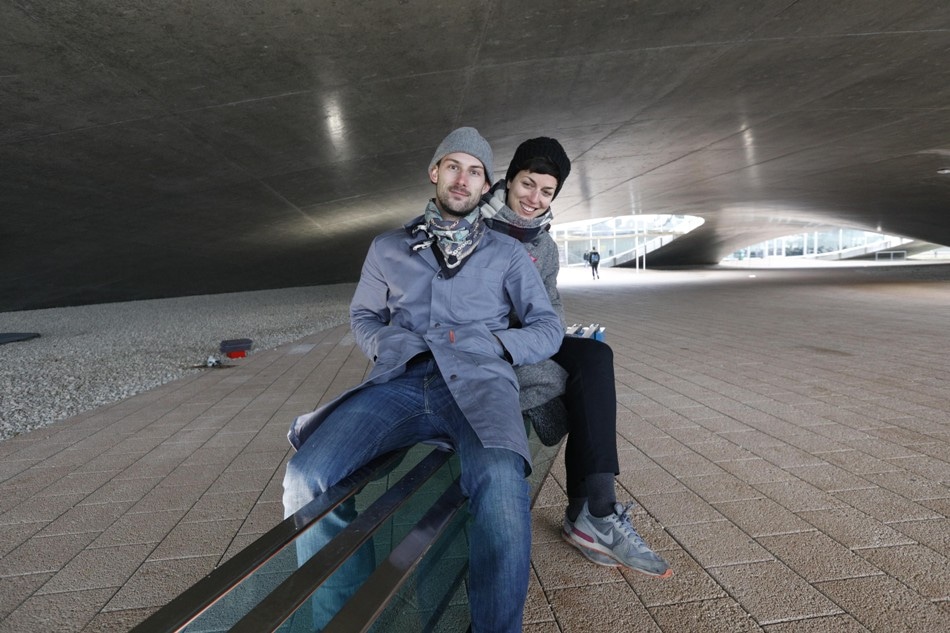Dec 21 2017
A bench has been made from exceptionally resistant glass by a PhD student in civil engineering at EPFL in collaboration with a recent architecture graduate. A number of companies broke new ground in order to extend their support for this highly innovative project.
 Alexander Wolhoff and Jagoda Cupać. © Marc Delachaux / EPFL 2017
Alexander Wolhoff and Jagoda Cupać. © Marc Delachaux / EPFL 2017
Jagoda Cupać, doctor in civil engineering, has established the possibility of changing glass into an ultra-resistant material, by combining her knowledge with that of EPFL architect Alexander Wolhoff. Their project? Developing a six-meter-long glass bench called ATLAS. A number of companies contributed to the success of this project by using materials and processes that were new to them. The ATLAS bench is considered to be a true technology prototype and will be displayed for a whole semester at the Rolex Learning Center.
In contemporary architecture, glass has been used for a number of applications other than for just windows. It is everywhere – in roofs, walls, floors, stairs and beams – and that is not likely to change anytime in the near future. Thus, like Atlas, the mythical figure destined to hold the sky upward for eternity, the engineers also had an epic challenge of their own, the concept of transforming glass into a load-bearing material that is considered to be as resilient as concrete or steel without losing its trademark transparency.
Reinforced and post-tensioned glass
For her Master's degree in civil engineering in Croatia, Cupać initially specialized in the resistance of glass. Following this, for her thesis at the Resilient Steel Structures Laboratory (RESSLAB), she focused on testing glass beams that had been reinforced and then post-tensioned with stainless steel pieces. The properties of these beams were not known and had hardly been studied earlier at EPFL. The steel is stretched mechanically, during the post-tensioning process, prior to being attached to the glass beam in order to make it more solid.
In order to identify the most solid structures, the researcher performed dozens of bending resistance tests. “The glass beams are prestressed using stainless steel bars that are then glued along the beams and attached at each end. The prestressing increases the glass's bending resistance. When a glass roof or floor is cracked by an exceptionally heavy load or by vandals, for instance, these beams can ensure that everybody inside and outside the building is safe because the beams take on the tensile strain and make the glass more ductile – meaning that it can handle major distortions. This prevents the structure from breaking immediately and without warning,” explains Cupać. The results of her research challenge preconceived concepts about the fragility of glass, which can actually be made as ductile and resilient as more standard load-bearing materials.
Three types of prestressed glass
Alonsgside the theoretical component of her thesis, Cupać suggests three types of prestressed glass capable of being directly applied in construction. That is how she came up with the idea of collaborating with Alexander Wolhoff, who recently completed a Master's in architecture at EPFL. “Working with an architect meant that I could apply my thesis findings directly to the construction sector. This adds an artistic angle, making the whole project more interesting,” says Cupać. Wolhoff also highlights the significance of sharing knowledge: “What made this combination of two different areas of expertise so enriching was that we had to pull each other out of our comfort zones and be inventive. The ATLAS project wouldn't have been possible without this in-depth exchange and our willingness to listen to each other.”
The ATLAS project
So that is how ATLAS originated. It is a bench made up of three post-tensioned glass beams reinforced with steel, and two support blocks developed from high-performance fiber-reinforced concrete (HPFRC). These blocks are tinted and a shiny varnish is used for covering them, and they then transfer the load from the beams to the ground. Wolhoff produced a unique type of concrete for the project, partly based on his own research. EPFL's Structural Maintenance and Safety Laboratory (MCS) helped construct the two supports. Christophe Loraux, a PhD student in the MCS Laboratory, was part of this project, advising Wolhoff to employ HPFRC instead of standard concrete, which has a number of drawbacks for this kind of application: “It made sense to use HPFRC because it goes well with glass. It meant we combined two highly resistant materials that are stable over time.” This could indeed be another affirmation to the Greek mythical figure.
The HPFRC produced from synthetic fibers, which was created by the MCS Laboratory, was thus chosen as it provided a number of benefits: it does not wear over time, is easy to cast, and mechanically resistant – both in terms of tensile strength and when compressed. The resulting material can lead to confusion: it appears to be more like porcelain than standard concrete. The ATLAS project plays with this visual aspect: the bench looks like something between porcelain and glass, and onlookers would indeed be forgiven for assuming it to be fragile.
Sparking the curiosity of sponsors
To obtain the other materials, the researchers had to satisfy prospective sponsors, as Cupać explains: “One Zurich-based company that specializes in prestressing through post-tension, a method used in the construction of concrete bridges, had never heard of this glass-steel combination and agreed to provide the steel at its own expense. And the adhesive we wanted tends to be used only in electronic components, even though we think it has great potential for other applications. It was all put together by a major constructor of glass facades that hadn’t heard of this type of beam before either.”
For the very first time, the ATLAS bench will be displayed outdoors on the EPFL campus before it could be moved to an indoor location that is more permanent. Cupać and Wolhoff are still on the lookout for the perfect spot.